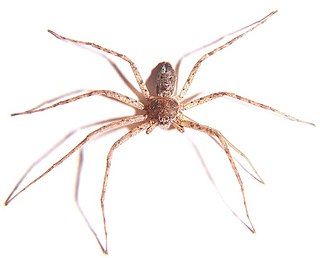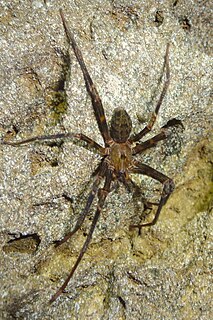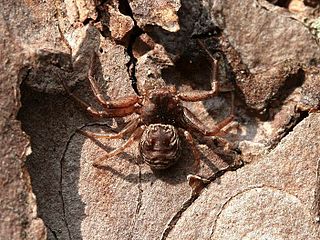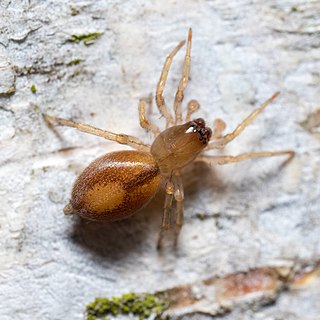
Philodromidae, also known as philodromid crab spiders and running crab spiders, is a family of araneomorph spiders first described by Tord Tamerlan Teodor Thorell in 1870. It contains over 500 species in thirty genera.

The Dionycha are a clade of spiders (Araneomorphae:Entelegynae), characterized by the possession of two tarsal claws with tufts of hairs (setae) beside them, which produce strong adhesion, enabling some species to climb glass. The circumscription of the group has varied widely; a 2021 analysis resulted in about 20 families, including Salticidae, Gnaphosidae, and Clubionidae.

Amyciaea is a genus of ant mimicking crab spiders that was first described by Eugène Louis Simon in 1885.

Spelungula is a monotypic genus of South Pacific large-clawed spiders containing the single species, Spelungula cavernicola, or the Nelson cave spider. It was first described by Ray Forster, Norman I. Platnick, & Michael R. Gray in 1987, and has only been found in caves in the northwestern part of New Zealand's South Island.

Coriarachne is a genus of crab spiders that was first described by Tamerlan Thorell in 1870. Over half of described species have been synonymized or moved to similar genera, including Bassaniana, Bassaniodes, and Pycnaxis.
Epidius is a genus of crab spiders that was first described by Tamerlan Thorell in 1877. It is a senior synonym of Pothaeus.
Entypesa is a genus of African mygalomorph spiders in the family Entypesidae. It was first described by Eugène Louis Simon in 1902. Originally placed with the curtain-web spiders, it was transferred to the funnel-web trapdoor spiders in 1985, then to the Entypesidae in 2020. It is a senior synonym of Pseudohermacha.
Pionothele is a genus of African mygalomorph spiders in the family Pycnothelidae. It was first described by William Frederick Purcell in 1902. As of June 2020 it contains three species, found in Namibia and South Africa: P. capensis, P. gobabeb, and P. straminea. Originally placed with the Ctenizidae, it was transferred to the funnel-web trapdoor spiders in 1985, then to the Pycnothelidae in 2020.
Quemedice is a genus of South American huntsman spiders that was first described by Cândido Firmino de Mello-Leitão in 1942. As of September 2019 it contains two species, found in Colombia, Argentina, and Brazil: Q. enigmaticus and Q. piracuruca. Originally placed with the Philodromidae, it was moved to the Sparassidae in 2008.
Eminella is a monotypic genus of Argentinian running crab spiders containing the single species, Eminella ctenops. It was first described by H. Özdikmen in 2007, and is only found in Argentina.

Ohlertidion is a genus of comb-footed spiders that was first described by J. Wunderlich in 2008. As of September 2019 it contains three species with a holarctic distribution, including Greenland: O. lundbecki, O. ohlerti, and O. thaleri. A 2019 genetic study proposed to synonymize this genus with Heterotheridion; however, the evidence was based predominantly on COI barcoding, which is a useful tool for separating species, but is less useful for determining higher taxa.

Ruborridion is a monotypic genus of Asian comb-footed spiders containing the single species, Ruborridion musivum. The species was first described under the name Theridion musivum in 1873. The genus was described by J. Wunderlich in 2011. They are found in India and in the mediterranean area

Ebrechtella is a genus of crab spiders that was first described by Friedrich Dahl in 1907.

Apollophanes is a genus of running crab spiders that was first described by Octavius Pickard-Cambridge in 1898.

Porrhoclubiona is a genus of sac spiders that was first described as a subgenus of Clubiona by H. Lohmander in 1944. Clubiona is a polyphyletic group that has been divided and reorganized many times, and whether this genus is a synonym of Clubiona or an independent genus is still under debate.
Iberattus is a genus of jumping spiders containing the single species, Iberattus semiglabratus. It was first described by Jerzy Prószyński in 2018, and has only been found in Portugal, Spain, and France. Prószyński separated Iberattus from Euophrys. The justification for doing so has been questioned, since it was based on the examination of a mixed collection of specimens where it was not clear whether the males and females belonged to the same species. Nevertheless, the genus is accepted by the World Spider Catalog as of August 2020.
Priscaleclercera is a genus of araneomorph spiders in the family Psilodercidae, containing seven species. The genus was first described by Jorge Wunderlich in 2017, and its fossils have been found in Burmese amber, while live specimens have been found in Indonesia (Sulawesi).
Spinosatibiapalpus is a genus of tarantulas erected by Gabriel and Sherwood in 2020 for a newly discovered species and two other previously described species bearing a unique palpal bulb morphology. The name is a reference to the spines found on the fourth section of the pedipalp in adult males. This distinctive feature was also found in Pseudhapalopus species, but because it is never mentioned in the original description of that genus, Gabriel and Sherwood called into question the validity of Pseudohapalopus, and moved all its species except P. aculeatus, known only from a single male found in Bolivia in 1907. It is impossible to place P. aculeatus because the holotype was destroyed when the museum housing it was bombed during World War II, and it has been declared as nomen dubium.
Spiracme is a genus of crab spiders erected by Anton Menge in 1876 to contain S. striata, transferred from Xysticus. The exact relationship of these spiders and their closest relatives has been long debated, and many included species have been transferred to and from similar genera, namely Xysticus and Ozyptila. Most recently, Rainer Breitling conducted a DNA barcoding study in 2019 and grouped similar species based on the results:









